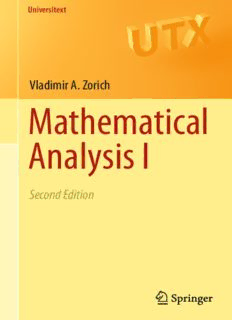
Mathematical Analysis I PDF
Preview Mathematical Analysis I
Universitext Vladimir A. Zorich Mathematical Analysis I Second Edition Universitext Universitext SeriesEditors SheldonAxler SanFranciscoStateUniversity,SanFrancisco,CA,USA VincenzoCapasso UniversitàdegliStudidiMilano,Milano,Italy CarlesCasacuberta UniversitatdeBarcelona,Barcelona,Spain AngusMacIntyre QueenMaryUniversityofLondon,London,UK KennethRibet UniversityofCalifornia,Berkeley,CA,USA ClaudeSabbah CNRS,ÉcolePolytechnique,Palaiseau,France EndreSüli UniversityofOxford,Oxford,UK WojborA.Woyczyn´ski CaseWesternReserveUniversity,Cleveland,OH,USA Universitext is a series of textbooks that presents material from a wide variety of mathematicaldisciplinesatmaster’slevelandbeyond.Thebooks,oftenwellclass- testedbytheirauthor,mayhaveaninformal,personalevenexperimentalapproach totheirsubjectmatter.Someofthemostsuccessfulandestablishedbooksinthese- rieshaveevolvedthroughseveraleditions,alwaysfollowingtheevolutionofteach- ingcurricula,toverypolishedtexts. Thus as research topics trickle down into graduate-level teaching, first textbooks writtenfornew,cutting-edgecoursesmaymaketheirwayintoUniversitext. Forfurthervolumes: www.springer.com/series/223 Vladimir A. Zorich Mathematical Analysis I Second Edition VladimirA.Zorich DepartmentofMathematics MoscowStateUniversity Moscow,Russia Translators: RogerCooke(firstEnglisheditiontranslatedfromthe4thRussianedition) Burlington,Vermont,USA and OctavioPaniaguaT.(AppendicesA–Fandnewproblemsofthe6thRussianedition) Berlin,Germany Original Russian edition: Matematicheskij Analiz (Part I, 6th corrected edition, Moscow, 2012)MCCME(MoscowCenterforContinuousMathematicalEducationPubl.) ISSN0172-5939 ISSN2191-6675(electronic) Universitext ISBN978-3-662-48790-7 ISBN978-3-662-48792-1(eBook) DOI10.1007/978-3-662-48792-1 LibraryofCongressControlNumber:2016930048 MathematicsSubjectClassification(2010): 26-01,26Axx,26Bxx,42-01 SpringerHeidelbergNewYorkDordrechtLondon ©Springer-VerlagBerlinHeidelberg2004,2015 Thisworkissubjecttocopyright.AllrightsarereservedbythePublisher,whetherthewholeorpartof thematerialisconcerned,specificallytherightsoftranslation,reprinting,reuseofillustrations,recitation, broadcasting,reproductiononmicrofilmsorinanyotherphysicalway,andtransmissionorinformation storageandretrieval,electronicadaptation,computersoftware,orbysimilarordissimilarmethodology nowknownorhereafterdeveloped. Theuseofgeneraldescriptivenames,registerednames,trademarks,servicemarks,etc.inthispublication doesnotimply,evenintheabsenceofaspecificstatement,thatsuchnamesareexemptfromtherelevant protectivelawsandregulationsandthereforefreeforgeneraluse. Thepublisher,theauthorsandtheeditorsaresafetoassumethattheadviceandinformationinthisbook arebelievedtobetrueandaccurateatthedateofpublication.Neitherthepublishernortheauthorsor theeditorsgiveawarranty,expressorimplied,withrespecttothematerialcontainedhereinorforany errorsoromissionsthatmayhavebeenmade. Printedonacid-freepaper SpringerispartofSpringerScience+BusinessMedia(www.springer.com) Prefaces PrefacetotheSecond EnglishEdition Science has not stood still in the years since the first English edition of this book was published. For example, Fermat’s last theorem has been proved, the Poincaré conjectureisnowatheorem,andtheHiggsbosonhasbeendiscovered.Otherevents inscience,whilenotdirectlyrelatedtothecontentsofatextbookinclassicalmath- ematical analysis, have indirectly led the author to learn something new, to think oversomethingfamiliar,ortoextendhisknowledgeandunderstanding.Allofthis additionalknowledgeandunderstandingendupbeingusefulevenwhenonespeaks aboutsomethingapparentlycompletelyunrelated.1 In addition to the original Russian edition, the book has been published in En- glish, German, and Chinese. Various attentive multilingual readers have detected manyerrorsinthetext.Luckily,thesearelocalerrors,mostlymisprints.Theyhave assuredlyallbeencorrectedinthisnewedition. ButthemaindifferencebetweenthesecondandfirstEnglisheditionsistheaddi- tionofaseriesofappendicestoeachvolume.Therearesixoftheminthefirstand fiveoftheminthesecond.Soasnottodisturbtheoriginaltext,theyareplacedatthe endofeachvolume.Thesubjectsoftheappendicesarediverse.Theyaremeanttobe usefultostudents(inmathematicsandphysics)aswellastoteachers,whomaybe motivatedbydifferentgoals.Someoftheappendicesaresurveys,bothprospective andretrospective.Thefinalsurveycontainsthemostimportantconceptualachieve- mentsofthewholecourse,whichestablishconnectionsbetweenanalysisandother partsofmathematicsasawhole. 1ThereisastoryaboutErdo˝s,who,likeHadamard,livedaverylongmathematicalandhuman life.Whenhewasquiteold,ajournalistwhowasinterviewinghimaskedhimabouthisage.Erdo˝s replied,afterdeliberatingabit,“IrememberthatwhenIwasveryyoung,scientistsestablishedthat theEarthwastwobillionyearsold.NowscientistsassertthattheEarthisfourandahalfbillion yearsold.So,Iamapproximatelytwoandahalfbillionyearsold.” v vi Prefaces Iwashappytolearnthatthisbookhasproventobeuseful,tosomeextent,not onlytomathematicians,butalsotophysicists,andeventoengineersfromtechnical schoolsthatpromoteadeeperstudyofmathematics. Itisarealpleasuretoseeanewgenerationthatthinksbigger,understandsmore deeply,andisabletodomorethanthegenerationonwhoseshouldersitgrew. Moscow,Russia V.Zorich 2015 PrefacetotheFirstEnglishEdition Anentiregenerationofmathematicianshasgrownupduringthetimebetweenthe appearance of the first edition of this textbook and the publication of the fourth edition,atranslationofwhichisbeforeyou.Thebookisfamiliartomanypeople, whoeitherattendedthelecturesonwhichitis basedor studiedoutof it, andwho now teach others in universities all over the world. I am glad that it has become accessibletoEnglish-speakingreaders. This textbook consists of two parts. It is aimed primarily at university students andteachersspecializinginmathematicsandnaturalsciences,andatallthosewho wishtoseeboththerigorousmathematicaltheoryandexamplesofitseffectiveuse inthesolutionofrealproblemsofnaturalscience. Note that Archimedes, Newton, Leibniz, Euler, Gauss, Poincaré, who are held in particularly high esteem by us, mathematicians, were more than mere math- ematicians. They were scientists, natural philosophers. In mathematics resolving of important specific questions and development of an abstract general theory are processes as inseparable as inhaling and exhaling. Upsetting this balance leads to problemsthatsometimesbecomesignificantbothinmathematicaleducationandin scienceingeneral. The textbook exposes classical analysis as it is today, as an integral part of the unified Mathematics, in its interrelations with other modern mathematical courses such as algebra, differential geometry, differential equations, complex and func- tionalanalysis. Rigor of discussion is combined with the development of the habit of working with real problems from natural sciences. The course exhibits the power of con- ceptsandmethodsofmodernmathematicsinexploringspecificproblems.Various examples and numerous carefully chosen problems, including applied ones, form aconsiderablepartofthetextbook.Mostofthefundamentalmathematicalnotions and results are introduced and discussed along with information, concerning their history,modernstateandcreators.Inaccordancewiththeorientationtowardnatural sciences,specialattentionispaidtoinformalexplorationoftheessenceandrootsof thebasicconceptsandtheoremsofcalculus,andtothedemonstrationofnumerous, sometimesfundamental,applicationsofthetheory. Forinstance,thereaderwillencounterheretheGalileanandLorentztransforms, the formula for rocket motion and the work of nuclear reactor, Euler’s theorem Prefaces vii onhomogeneousfunctionsandthedimensionalanalysisofphysicalquantities,the LegendretransformandHamiltonianequationsofclassicalmechanics,elementsof hydrodynamics and the Carnot’s theorem from thermodynamics, Maxwell’s equa- tions,theDiracdelta-function,distributionsandthefundamentalsolutions,convo- lution and mathematical models of linear devices, Fourier series and the formula fordiscretecodingofacontinuoussignal,theFouriertransformandtheHeisenberg uncertaintyprinciple,differentialforms,deRhamcohomologyandpotentialfields, thetheoryofextremaandtheoptimizationofaspecifictechnologicalprocess,nu- mericalmethodsandprocessingthedataofabiologicalexperiment,theasymptotics oftheimportantspecialfunctions,andmanyothersubjects. Within each major topic the exposition is, as a rule, inductive, sometimes pro- ceeding from the statement of a problem and suggestive heuristic considerations concerning its solution, toward fundamental concepts and formalisms. Detailed at first,theexpositionbecomesmoreandmorecompressedasthecourseprogresses. Beginningabovothebookleadstothemostup-to-datestateofthesubject. Notealsothat,attheendofeachofthevolumes,onecanfindthelistofthemain theoreticaltopicstogetherwiththecorrespondingsimple,butnonstandardproblems (takenfromthemidtermexams),whichareintendedtoenablethereaderbothde- termine his or her degree of mastery of the material and to apply it creatively in concretesituations. Morecompleteinformationonthebookandsomerecommendationsforitsusein teachingcanbefoundbelowintheprefacestothefirstandsecondRussianeditions. Moscow,Russia V.Zorich 2003 viii Prefaces PrefacetotheSixthRussianEdition On my own behalfand on behalf of future readers, I thankall those, living in dif- ferent countries, who had the possibility to inform the publisher or me personally abouterrors(typos,errors,omissions),foundinRussian,English,GermanandChi- neseeditionsofthistextbook. As it turned out, the book has been also very useful to physicists; I am very happy about that. In any case, I really seek to accompany the formal theory with meaningfulexamplesofitsapplicationbothinmathematicsandoutsideofit. Thesixtheditioncontainsaseriesofappendicesthatmaybeusefultostudents and lecturers. Firstly, some of the material is actually real lectures (for example, the transcription of two introductory survey lectures for students of first and third semesters),and,secondly,thisissomemathematicalinformation(sometimesofcur- rentinterest,suchastherelationbetweenmultidimensionalgeometryandthetheory ofprobability),lyingclosetothemainsubjectofthetextbook. Moscow,Russia V.Zorich 2011 PrefacetotheSecondRussianEdition In this second edition of the book, along with an attempt to remove the misprints that occurred in the first edition,2 certain alterations in the exposition have been made(mainlyinconnectionwiththeproofsofindividualtheorems),andsomenew problemshavebeenadded,ofaninformalnatureasarule. Theprefacetothefirsteditionofthiscourseofanalysis(seebelow)containsa generaldescriptionofthecourse.Thebasicprinciplesandtheaimoftheexposition are also indicated there. Here I would like to make a few remarks of a practical natureconnectedwiththeuseofthisbookintheclassroom. Usually both the student and the teacher make use of a text, each for his own purposes. Atthebeginning,bothofthemwantmostofallabookthatcontains,alongwith the necessary theory, as wide a variety of substantial examples of its applications aspossible,and,inaddition,explanations,historicalandscientificcommentary,and descriptionsofinterconnectionsandperspectivesforfurtherdevelopment.Butwhen preparingforanexamination,thestudentmainlyhopestoseethematerialthatwill beontheexamination.Theteacherlikewise,whenpreparingacourse,selectsonly thematerialthatcanandmustbecoveredinthetimeallotedforthecourse. In this connection, it should be kept in mind that the text of the present book is noticeably more extensive than the lectures on which it is based. What caused 2Noneedtoworry:inplaceofthemisprintsthatwerecorrectedintheplatesofthefirstedition (whichwerenotpreserved),onemaybesurethatahostofnewmisprintswillappear,whichso enliven,asEulerbelieved,thereadingofamathematicaltext. Prefaces ix this difference? First of all, the lectures have been supplementedby essentially an entireproblembook,madeupnotsomuchofexercisesassubstantiveproblemsof science or mathematics proper having a connection with the corresponding parts of the theory and in some cases significantly extending them. Second, the book naturallycontainsamuchlargersetofexamplesillustratingthetheoryinactionthan onecanincorporateinlectures.Thirdandfinally,anumberofchapters,sections,or subsections were consciously written as a supplement to the traditional material. Thisisexplainedinthesections“Ontheintroduction”and“Onthesupplementary material”intheprefacetothefirstedition. I would also like to recall that in the preface to the first edition I tried to warn both the student and the beginning teacher against an excessively long study of theintroductoryformalchapters.Suchastudywouldnoticeablydelaytheanalysis properandcauseagreatshiftinemphasis. To show what in fact can be retained of these formal introductory chapters in a realistic lecture course, and to explain in condensed form the syllabus for such a course as a whole while pointing out possible variants depending on the student audience,at the end of the book I give a list of problems from the midtermexam, alongwithsomerecentexaminationtopicsforthefirsttwosemesters,towhichthis firstpartofthebookrelates.Fromthislisttheprofessionalwillofcoursediscernthe orderofexposition,thedegreeofdevelopmentofthebasicconceptsandmethods, andtheoccasionalinvocationofmaterialfromthesecondpartofthetextbookwhen thetopicunderconsiderationisalreadyaccessiblefortheaudienceinamoregeneral form. InconclusionIwouldliketothankcolleaguesandstudents,bothknownandun- knowntome,forreviewsandconstructiveremarksonthefirsteditionofthecourse. ItwasparticularlyinterestingformetoreadthereviewsofA.N.Kolmogorovand V.I.Arnol’d.Verydifferentinsize,form,andstyle,thesetwohave,ontheprofes- sionallevel,somanyinspiringthingsincommon. Moscow,Russia V.Zorich 1997 FromthePrefacetothe FirstRussianEdition ThecreationofthefoundationsofthedifferentialandintegralcalculusbyNewton andLeibnizthreecenturiesagoappearsevenbymodernstandardstobeoneofthe greatesteventsinthehistoryofscienceingeneralandmathematicsinparticular. Mathematical analysis (in the broad sense of the word) and algebra have inter- twinedtoformtherootsystemonwhichtheramifiedtreeofmodernmathematics issupportedandthroughwhichitmakesitsvitalcontactwiththenonmathematical sphere.Itisforthisreasonthatthefoundationsofanalysisareincludedasaneces- saryelementofevenmodestdescriptionsofso-calledhighermathematics;anditis probablyforthatreasonthatsomanybooksaimedatdifferentgroupsofreadersare devotedtotheexpositionofthefundamentalsofanalysis.
Description: